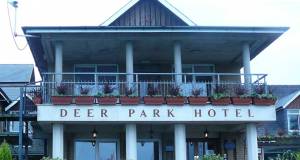
- General
- Posted
Planning guidance to cut carbon emissions previewed at IGBC conference
The implications of planning on Ireland’s carbon emissions and the importance of building climate-safe homes were discussed at the Irish Green Building Council’s (IGBC) annual residential conference, Better Homes.
This article was originally published in issue 46 of Passive House Plus magazine. Want immediate access to all back issues and exclusive extra content? Click here to subscribe for as little as €15, or click here to receive the next issue free of charge
While Ireland’s carbon emissions keep increasing and with 400,000 homes to be delivered in the next decade, the IGBC presented a sneak peek of a new guidance document for planners. The document, developed by Construct Innovate in partnership with the Irish Green Building Council and University College Dublin, includes recommendations to better address emissions caused by the construction of new housing developments. More specifically, it shows that significant decreases in carbon emissions could be achieved by rethinking the use of carbon-intensive construction materials in our dwellings, and by adopting planning approaches that minimise car-parking, new roads, and infrastructure.
The insights show that greenfield housing developments outside towns and cities can contribute up to 30 per cent more embodied carbon per home than equivalent infill developments that use existing infrastructure.
These embodied carbon emissions are generated from the production of construction materials, transport of materials, construction process, maintenance, repair, and demolition of buildings. The document recommends prioritising housing development on empty or under-utilised lands in existing urban centres and building connected neighbourhoods with minimised parking areas. Both planning actions could play a significant role in reducing emissions associated with the built environment. They are also crucial to addressing transport emissions since they reduce dependency on cars and car use. Furthermore, the guidance document highlights that connected dwellings such as terraced houses, lead to a consistent reduction in terms of carbon emissions. A side gable wall, which is typically found in semi-detached houses, generates approximately 4-5 times more embodied carbon per square metre than a party wall between dwellings on a terrace.
IGBC CEO Pat Barry said: "The next decade is critical in our battle against climate change, and we need to remember that embodied carbon emissions cannot be retrofitted. We must get our homes right from the beginning. The encouraging thing is that implementing these principles won't just reduce emissions, but it will enable us to deliver much-needed homes with limited financial and human resources. It also presents a fantastic opportunity to build vibrant communities and to enhance our quality of life.”
Over 150 building professionals, from across the value chain, gathered for Better Homes 2023. In addition to the importance of getting planning right, they heard that homes built today must be climate-proof since the impacts of climate change are partially already irreversible.
Julie Clarke, assistant professor in Engineering for Climate Action at Trinity College Dublin said: "The need to ensure the resilience of residential buildings to climate change impacts has become apparent in recent years as we have witnessed some of the devasting impacts that our changing climate is having on our homes. We need to think about where we build our homes given sea level rise, flooding, and coastal erosion. We also need to think about what we are building and how we can retrofit existing homes to adapt to our changing climate. For example, is there a risk of overheating in our homes in the future?”
A notable example of actions that can be taken to adapt to a changing climate is represented by the “Sponge City”. This concept has been successfully implemented in Copenhagen and presented at the conference by Neil Mclean Goring from the engineering & architecture consultancy Ramboll: "Following a devastating storm in 2011, the Danish capital implemented a comprehensive, catchment-based masterplan of blue and green infrastructure to protect the city from episodes of severe rainfall for the next century. We developed a nature-based and multifunctional approach, redesigning the parks and streets throughout Copenhagen to detain and absorb vast amounts of stormwater, like a sponge. This proactive and sustainable approach has already been implemented in cities such as New-York and Melbourne, and it holds the potential to be adopted by other towns and cities around the world, including in Ireland."
The full guidance document will be released in early 2024 and made available at www.igbc.ie
Related items
-
 #BuildingLife Series: Director at CORA Consulting Engineers, John Casey
#BuildingLife Series: Director at CORA Consulting Engineers, John Casey -
 Green homes and finance join forces for growth
Green homes and finance join forces for growth -
 Hotel demolition judicial review could set embodied carbon precedent
Hotel demolition judicial review could set embodied carbon precedent -
 ZEB Summit celebrates Irish passive progress
ZEB Summit celebrates Irish passive progress -
 Irish and British associations unite for conference as passive house explodes
Irish and British associations unite for conference as passive house explodes -
 IGBC launches case studies to drive nature-led construction
IGBC launches case studies to drive nature-led construction


